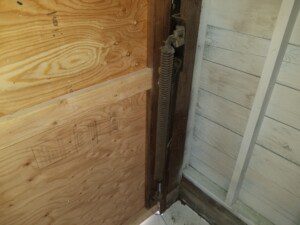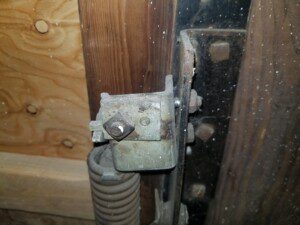
- No containment cable for a manual garage door opener spring
Older garage door openers used a system of springs and levers to enable people to lift big heavy doors, usually made from wood. The springs help to displace the weight of the door, and also help to keep the door in the open position. Since the springs operate under significant tension, if the spring breaks it could cause damage to the building or injury to the person using the door. To help prevent the spring from becoming a dangerous projectile, a containment cable is installed through the center of the spring. A manual garage door opener with a missing containment cable inside the spring is a safety hazard and should be corrected by a licensed contractor.
- Damaged, loose or deteriorated components at manual garage door openers

- Garage door safety eyes missing, or installed too high or too low
Modern garage door openers should be equipped with safety motion sensors, so that the door can reverse, or stop moving when someone or something is traveling under the door. When mechanical garage door openers were first invented, they were not equipped with safety eyes, and unfortunately people, including children were injured by closing garage doors. Home inspectors sometimes find older automatic garage door openers that are not equipped with safety eyes (motion sensors), but more commonly the safety eyes are installed too high. Motion sensor safety eyes should be installed at every automatic garage door opener, and should be installed between 4 – 6 inches from the floor, and no higher than 6 inches from the floor.
- Garage door fails to reverse when met with resistance
Another safety feature modern mechanical garage door openers have is automatic reverse function when the door senses resistance during operation. If motion sensor safety eyes are missing or fail to operate, the door should be able to reverse or stop moving when it senses resistance. Most automatic garage door openers have a resistance setting, and should be adjusted in a way that can allow the door to open and close under normal circumstances, and reverse or stop moving when it senses resistance, such as from an object or person under the door.
- Automatic garage door opener switch installed too low
Automatic garage door opener switches than can be accessed by children can allow the door to be operated by children. This is a potential dangerous condition, and could allow children to leave the home when they are not supposed to, or be vulnerable to moving parts as the door opens. Automatic garage door openers should be installed no less than 60 inches from the ground.
Check out the video below about how to adjust resistance settings on an automatic garage door opener.
